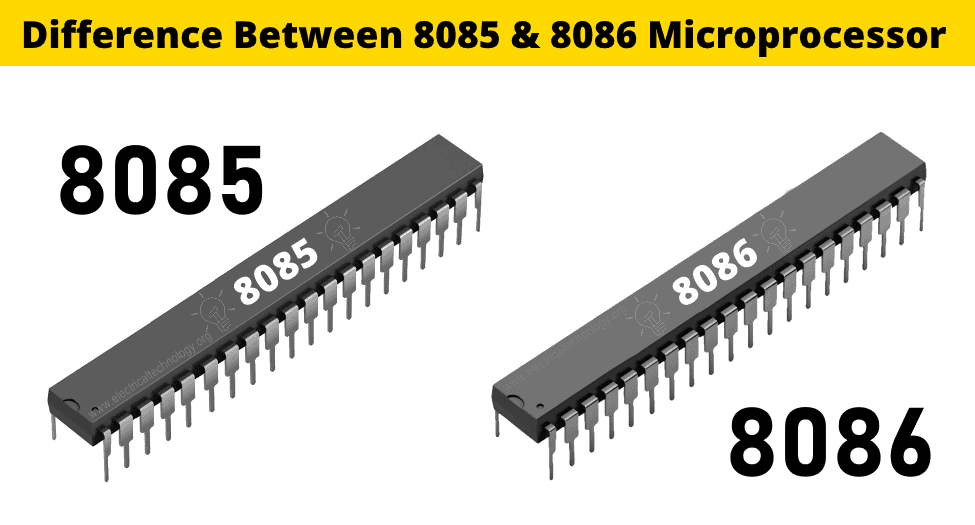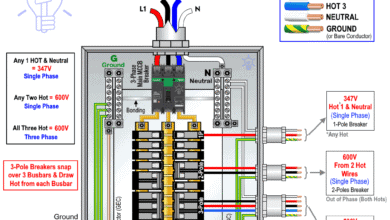Difference Between 8085 & 8086 Microprocessor – Comparison
Key Difference Between 8085 and 8086 Microprocessor
The 8085 and 8086 are both different versions of microprocessors produced by Intel in the ’70s. They are the most common available microprocessors. In this article, we are going to discuss the differences between 8085 and 8086 microprocessor.
Before going any further into their differences, let’s discuss the basics of a microprocessor and also 8085 & 8086 microprocessors.
What is a Microprocessor?
A microprocessor is an electronic chip that functions as a central processing unit or the brain of a computer or microcontroller. It is made up of millions of transistors, diodes and resistors and it is responsible for any arithmetic or logical operation. The microprocessors operate on binary data in the form of “0” & “1”.
The microprocessors do not have RAM or ROM inside it. But they do have registers to stores the results from the ALU (Arithmetic Logic Unit). It includes interfaces to connect the external ROM and RAM to the processors.
There are different types of Microprocessors classified based on various features. Please refer to the article types of microprocessor for more information.
- Related Post: Difference Between Microprocessor and Microcontroller
What is 8085 Microprocessor?
The 8085 pronounced as “Eighty-Eighty-five” is an 8-bit microprocessor first introduced by Intel in the year 1976. Its data bus is 8-bit long which means it can process 8-bit of data at a time. Its address bus is 16-bit wide which means it can access 216 different memory locations. Since each memory location contains a byte (8-bit) of data, the maximum accessible memory capacity of 8085 becomes 216 or 64KB. It is equipped with an on-chip internal oscillator of 3 MHz.
The reason it has an 8-bit data bus is that it has an 8-bit ALU (Arithmetic Logic Unit). Its ALU is capable of the operations such as, add, subtract, increase, decrease, compare, shift, complement, ADD, OR, X-OR.
The 8085 is an accumulator based microprocessor which means the data being used for operation and the results of the ALU are stored in the accumulator. It also stores the intermediate results of the ALU.

The 8085 performs sequential execution of the instruction in this order; fetching, decoding and execution. It does not support pipelining.
- Related Post: Difference Between CPU and GPU – Comparison
What is 8086 Microprocessor?
The 8086 is a 16-bit microprocessor introduced by Intel in 1976. It is the enhanced version of the 8085 microprocessor. It has a 16-bit data bus with a 16 bit ALU. The address bus is 20-bit long; therefore the accessible memory capacity of 8086 microprocessor is 220 Bytes or 1MB. it is available in various versions with a clock frequency of 5 MHz, 8 MHz and 10 MHz.
It has a 16-bit ALU capable of performing all the operations of 8085’s ALU and also the operation of Multiplication and Division.
It is a general-purpose register-based microprocessor. It uses registers to stores the data being used and the results and the intermediate results from the ALU. There are 14 internal registers each 16-bit wide.
The internal architecture of the 8086 is divided into two parts that operate independently; The Bus Interface Unit (BIU) and Execution Unit (EU). The BIU is used for interfacing external components, fetching instruction and maintaining prefetch instruction queues also known as pipelining. It helps in increasing the execution speed of the instruction by fetching the next instruction while executing the current instructions. The EU contains ALU and registers that fetch the instruction from BIU, decode it and execute it.
The 8086 has two modes of operation known as minimum mode and maximum mode. The minimum mode used for an application that uses the only single processor. While the maximum mode is used for devices using more than one processor or multiprocessor that shares a common RAM. The maximum mode allows the coprocessor to reduce the workload from the primary processor.

The 8086 memory is segmented i.e. the 20-bit address bus can access 1MB of memory but it only uses the four 64KB segments from it. This increases the execution speed of the processor by providing different segments for different operations.
- Related Post: Difference Between RAM and ROM – Comparison
Mai Differences between 8085 and 8086 Microprocessor
| 8085 Microprocessor | 8086 Microprocessor |
| It is an 8-bit microprocessor. | It is a 16-bit microprocessor. |
| It has an 8-bit wide data bus. | It has 16-bit wide data bus. |
| It can address 28 = 256 I/O ports. | It can address 216 = 65,536 I/O ports. |
| It has 16-bit wide address bus. | It has 20-bit wide address bus. |
| It has an 8-bit ALU (Arithmetic Logic Unit). | It has a 16-bit ALU. |
| It can process an 8-bit of data in one machine cycle. | It can process 16-bit of data in one machine cycle |
| The maximum accessible memory (RAM) it can access is 216 = 64KB. | The maximum accessible memory of 8086 is 220 = 1MB. |
| Its memory is not segmented. | Its memory is segmented into four blocks of 64KB. |
| It has an on-chip oscillator of 3 MHz. | It is available in 3 versions with a clock frequency of 5 MHz, 8 MHz and 10 MHz. |
| It is an Accumulator based Microprocessor. | It is a General Purpose Register based Microprocessor. |
| It does not have Multiplication and division instruction. | Its ALU can perform multiplication and division. |
| It has 5 flags (carry, auxiliary carry, parity, zero and sign flag). | It has 9 flags (carry, auxiliary carry, parity, zero, sign, trap, interrupt, direction and overflow flag). |
| It does not have an instruction queue. | It has an instruction queue of 6 bytes that is stored in FIFO (First In First Out) register. |
| The 8085 does not support the pipelined architecture. | It supports pipelined architecture which increases the execution speed. |
| It supports only the single mode of operation. i.e. a single processor mode. It does not support external processors. | It has two modes of operation; minimum (single Processor mode) and maximum mode (Multiprocessor mode) which supports external processors. |
| It is cheaper than the 8086 microprocessor. | It is expensive than the 8085 microprocessor. |
Advantages of 8086 over 8085 Microprocessor
There are some advantages of 8086 over 8085 e.g. more memory, faster clock speeds, backward compatibility, sort of better math etc. some of them are as follows:
- 8086 is 16 bit microprocessor whereas 8085 is 8 bit microprocessor.
- 8086 has 20 bit address bus while 8085 has 16 bit address buss.
- 8086 can access up to 220 = 1MB of memory, whereas the 8085 can access up to 216 = 64KB if memory.
- 8086 can support pipelined architecture, whereas 8085 doesn’t.
- 8086 supports multiprocessing while 8085 doesn’t.
- 8086 can address 216 = 65,536 I/O ports, whereas, 8085 can address 28 = 256 I/O ports.
- 8086 supports integer, decimal and ASCII arithmetic, whereas 8085 only supports integer and decimal.
- 8086 supports multiplication and division, whereas 8085 doesn’t support this job.
- 8086 operates in two modes, whereas 8085 operates in single operating mode.
The 8086 is a more advanced, efficient and fast operating microprocessor then 8085 but it is also more expensive. However, the selection between 8085 and 8086 microprocessor depends on the application they are being used for. You do not need an expensive, fast processor for a simple task that can be efficiently done using a cheaper microprocessor.
Related Posts:
- Difference between Analog and Digital Circuit – Digital vs Analog
- Difference between Inverter & UPS – Uninterruptible Power Supply
- Difference Between Online UPS and Offline UPS – Which One is Better?
- Difference between Electrical and Electronics Engineering
- How to Make and LED Project with ATMega Microcontrollers?
- How to Program PIC18 Microcontroller in C?








Please teach programming of 8085&8086 processors